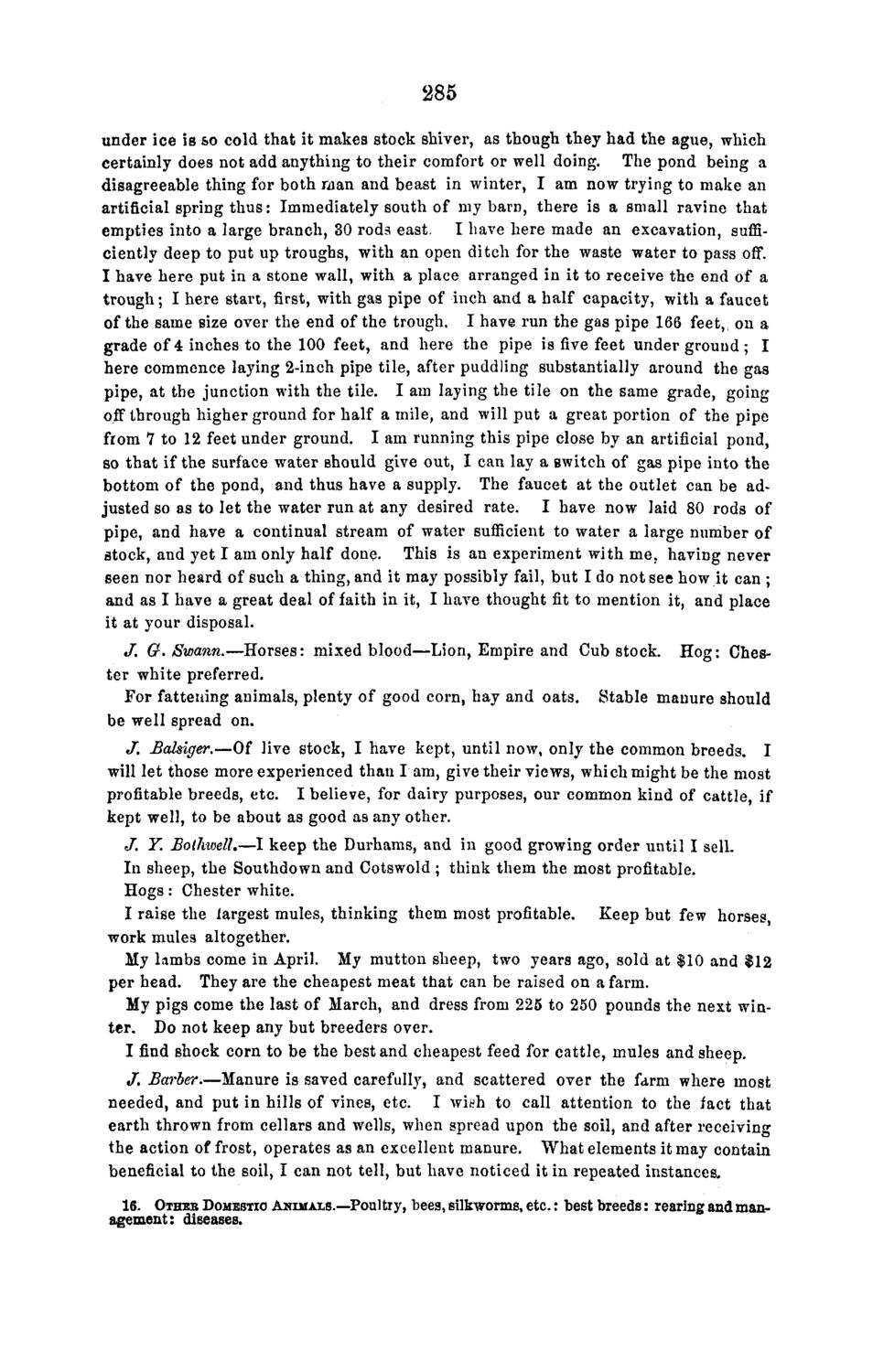| |
| |
Caption: Board of Trustees Minutes - 1868
This is a reduced-resolution page image for fast online browsing.

EXTRACTED TEXT FROM PAGE:
285 under ice is so cold that it makes stock shiver, as though they had the ague, which certainly does not add anything to their comfort or well doing. The pond being a disagreeable thing for both man and beast in winter, I am now trying to make an artificial spring thus: Immediately south of my barn, there is a small ravine that empties into a large branch, 30 rods east. I have here made an excavation, sufficiently deep to put up troughs, with an open ditch for the waste water to pass off. I have here put in a stone wall, with a place arranged in it to receive the end of a trough; I here start, first, with gas pipe of inch and a half capacity, with a faucet of the same size over the end of the trough. I have run the gas pipe 166 feet,, on a grade of 4 inches to the 100 feet, and here the pipe is five feet under ground ; I here commence laying 2-inch pipe tile, after puddling substantially around the gas pipe, at the junction with the tile. I am laying the tile on the same grade, going off through higher ground for half a mile, and will put a great portion of the pipe from 7 to 12 feet under ground. I am running this pipe close by an artificial pond, so that if the surface water should give out, I can lay a switch of gas pipe into the bottom of the pond, and thus have a supply. The faucet at the outlet can be adjusted so as to let the water run at any desired rate. I have now laid 80 rods of pipe, and have a continual stream of water sufficient to water a large number of stock, and yet I am only half done. This is an experiment with me. having never seen nor heard of such a thing, and it may possibly fail, but I do not see how it can ; and as I have a great deal of faith in it, I have thought fit to mention it, and place it at your disposal. J. G. JSwann.—Horses: mixed blood—Lion, Empire and Cub stock. Hog: Chester white preferred. For fattening animals, plenty of good corn, hay and oats. Stable manure should be well spread on. J. Balsiger.—Of live stock, I have kept, until now, only the common breeds. I will let those more experienced than I am, give their views, which might be the most profitable breeds, etc. I believe, for dairy purposes, our common kind of cattle, if kept well, to be about as good as any other. J. Y. BolJiwell.—I keep the Durhams, and in good growing order until I sell. In sheep, the Southdown and Cotswold ; think them the most profitable. Hogs: Chester white. I raise the largest mules, thinking them most profitable. Keep but few horses, work mules altogether. My lambs come in April. My mutton sheep, two years ago, sold at $10 and $12 per head. They are the cheapest meat that can be raised on a farm. My pigs come the last of March, and dress from 225 to 250 pounds the next winter. Do not keep any but breeders over. I find shock corn to be the best and cheapest feed for cattle, mules and sheep. J. Barber.—Manure is saved carefully, and scattered over the farm where most needed, and put in hills of vines, etc. I wish to call attention to the fact that earth thrown from cellars and wells, when spread upon the soil, and after receiving the action of frost, operates as an excellent manure. What elements it may contain beneficial to the soil, I can not tell, but have noticed it in repeated instances, 16. OTHBB DOMESTIC ANIMALS.—Poultry, bees, silkworms, etc.: best breeds: rearing and management: diseases.
| |